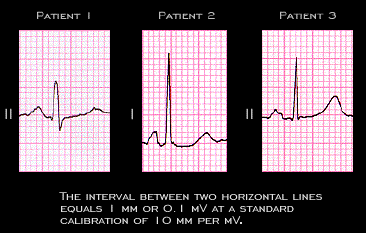
The amplitude of the normal P wave does not usually exceed 2.5mm (0.25 mV) at the standard calibration of 10 mm per mV. This figure shows the tallest P wave and the lead in which they were recorded from each of the three patients whose ECGs were shown earlier. A number of factors, such as the patient's body build, the presence of pericardial or pleural effusions or of tissue edema, and the position of the heart within the thorax will impact on the proximity of the electrodes to the heart and/or on electrical conductivity and thus on the amplitude of the P wave (as well as that of the QRS and T wave) recorded on the body surface.
